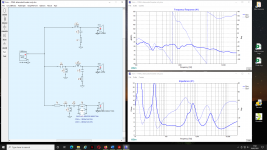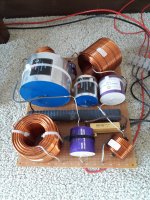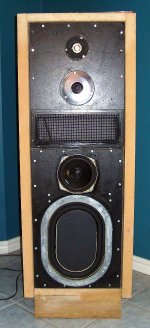Volt RV3863 bass (8 ohm)
Volt VM752 mid (8 ohm)
Scanspeak D2904/710003 treble (4 ohm)
The Volts were easy to match but it took a lot of trail and error to get the Scanspeak to integrate. Ultimately I rolled it off from about 4.5k at 2dB/octave and matched it with a series resistor. Finally, they were raised by 12cm on custom spiked stands.
I have never heard more accurate, realistic or uncoloured speakers at any price and that includes electrostatics.
Volt VM752 mid (8 ohm)
Scanspeak D2904/710003 treble (4 ohm)
The Volts were easy to match but it took a lot of trail and error to get the Scanspeak to integrate. Ultimately I rolled it off from about 4.5k at 2dB/octave and matched it with a series resistor. Finally, they were raised by 12cm on custom spiked stands.
I have never heard more accurate, realistic or uncoloured speakers at any price and that includes electrostatics.
The Volt midrange is meant to be a clone of the ATC75-150 ( although the ATC is 16 Ohm) and the Scanspeak I have is similar to yours. Are you prepared to share your crossover circuit please? It would be very helpful. I have been doing a lot of reading about crossover designs but more with the aim of altering the standard WA crossover I have.
I have managed to make a .mp4a file of the sibilance problem problem I have but that isn't an accepted file extension on this forum so I can't attach it 🙁
I have managed to make a .mp4a file of the sibilance problem problem I have but that isn't an accepted file extension on this forum so I can't attach it 🙁
View attachment Sibilance on ATC75-150.mp4
Well that was easy. I found some app to convert it. This is a .mp4 sample of the very noticeable distortion I have. Sound quality isn't good but the distortion is so egregious you can easily detect the sibilant on the high notes.
Well that was easy. I found some app to convert it. This is a .mp4 sample of the very noticeable distortion I have. Sound quality isn't good but the distortion is so egregious you can easily detect the sibilant on the high notes.
I've uploaded the XSim page. I wouldn't recommend trying to adapt the WA crossover. Better to start afresh. Get XSim (it's free), buy Omnimic, connect up to laptop, play the CD sweep tracks
and take readings for all three drivers individually (installed in the cabinet). Create FRD and ZMA files, load them into XSim and play around with the circuit until you find a good setup. It's really easy and intuitive.
and take readings for all three drivers individually (installed in the cabinet). Create FRD and ZMA files, load them into XSim and play around with the circuit until you find a good setup. It's really easy and intuitive.
CD94,
I do not know how the kinds of image “URLs" you are trying to post, but it is not working, i have had to fix yor last 2 pictures.
Please attach them to your post.
dave
diyaueio moeration tear
I do not know how the kinds of image “URLs" you are trying to post, but it is not working, i have had to fix yor last 2 pictures.
Please attach them to your post.
dave

diyaueio moeration tear
Thank you everyone, that is very helpful indeed. And CD94's circuit diagram looks like a very good starting point.
I have eventually got my microphone to work after unplugging all other USB peripherals. Rather than swamp you with graphs here is the one I took on REW at a distance of one metre. I am not an expert but surely the fall off at around 7K can't be right ?
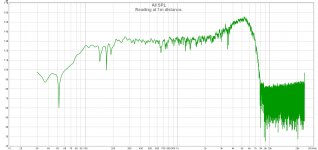
And this is the distortion plot but my studies of the subject so far haven't given me any real understand of what this is trying to tell me😕
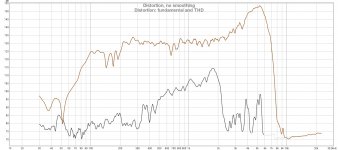
But note the cheap mic I am using optimistically claims a freq range of 50 - 16KHz.
I certainly agree that starting by building a new crossover is a better option.
Once again many thanks for your help and advice, I am very grateful.
I have eventually got my microphone to work after unplugging all other USB peripherals. Rather than swamp you with graphs here is the one I took on REW at a distance of one metre. I am not an expert but surely the fall off at around 7K can't be right ?

And this is the distortion plot but my studies of the subject so far haven't given me any real understand of what this is trying to tell me😕

But note the cheap mic I am using optimistically claims a freq range of 50 - 16KHz.
I certainly agree that starting by building a new crossover is a better option.
Once again many thanks for your help and advice, I am very grateful.
The roll-off and possibly the rise is likely the response of the microphone. The crossover regions look smooth suggesting the crossover is not broken like the one in the long thread.
The distortion curve shows OK levels for the tweeter and woofer but high levels for the midrange. This is solid evidence that the midrange is broken in some way. Are both drivers the same? What can you see from inspection? Is there something in the coil gap?
PS This is the full speaker and not just the midrange?
The distortion curve shows OK levels for the tweeter and woofer but high levels for the midrange. This is solid evidence that the midrange is broken in some way. Are both drivers the same? What can you see from inspection? Is there something in the coil gap?
PS This is the full speaker and not just the midrange?
Last edited:
Yes all the graphs are from the full speaker ( where the xover is very hard to get at now ). Both the ATC mid ranges give the same distortion. The other one isn't yet in the cabinet and the following graphs are from this one on its own and just resting at the edge of a table.
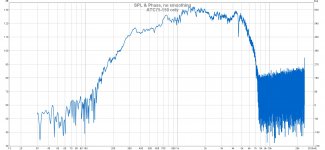
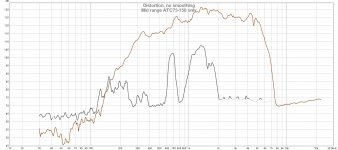
I was rather hoping the ATC's wern't faulty: they cost a fortune and are straight out of their boxes, but unfortunately I bought them 10 years ago ( they have been stored in their boxes in the spare bedroom).
My main hobby is woodworking not speaker building which is why this project has had to wait its turn after doing up the house 🙂


I was rather hoping the ATC's wern't faulty: they cost a fortune and are straight out of their boxes, but unfortunately I bought them 10 years ago ( they have been stored in their boxes in the spare bedroom).
My main hobby is woodworking not speaker building which is why this project has had to wait its turn after doing up the house 🙂
I was rather hoping the ATC's wern't faulty: they cost a fortune and are straight out of their boxes, but unfortunately I bought them 10 years ago ( they have been stored in their boxes in the spare bedroom).
Well it is good that a rough and ready measurement has progressed things by showing that the crossover looks OK and that there is an issue with both midrange drivers. That long thread would never have happened had the OP taken the time to diagnose the problem in the way you have done.
If you cannot see or feel what the issue is with the drivers such as something in the gap then I would suggest ringing ATC to discuss what may be wrong. These are high priced pro drivers and support maintaining and repairing them is part of what ATC offer. This is unlikely to be the case with home drivers like your Scan-Speak tweeter and so if you are going to have a problem with a driver it is good that it is the midrange.
I would also suggest putting concerns about the crossover aside until the drivers are fixed. The crossover may be a bit basic for a speaker at this price point but the drivers are well behaved and so the result may be fine.
ATC's website has a dialogue box for reporting a problem so I will use that first.
Btw the ATC on its own was fed through the crossover. I assume it is unsafe to connect a driver directly to the amp's output?
Btw the ATC on its own was fed through the crossover. I assume it is unsafe to connect a driver directly to the amp's output?
Btw the ATC on its own was fed through the crossover. I assume it is unsafe to connect a driver directly to the amp's output?
One needs to take care with the fine wires in a tweeter to take account of the significant additional power from the mid and low frequencies and perhaps the turn on/off thumps from the power amplifier. Woofers and midranges generally have higher power handling and do not need to be handled with the same level of care as a tweeter. The motor in your midrange is not far off that of a typical 12" woofer and can be expected to be pretty robust.
If there is any question about the crossover (DIYed and from Wilmslow) I would suggest a quick check without it in circuit would be wise.
I connected it direct to speaker outputs. Still plenty of distortion. I aso checked there was no DC present on the speaker outlets: hardly likely but easy to check.
I have filled in the form required by ATC and await their reply. In the meantime my 43 year old Kef TL system still sounds vg 🙂
Thanks everyone for your valuable help in diagnosing the problem.
I have filled in the form required by ATC and await their reply. In the meantime my 43 year old Kef TL system still sounds vg 🙂
Thanks everyone for your valuable help in diagnosing the problem.
Hi MGC,
I hope ATC help you out and repair the drivers, when fixed they are awesome... I have heard several ATC monitors in studios over the years and when active with good amps they really are fab!
May I suggest a left field solution to really maximize the drivers and the driver/room interaction and teach you a huge amount about crossover slopes/crossover points, level matching and Eq... All for £400!
This amazing piece of kit DriveRack PA2 | dbx Professional Audio will allow you to fine tune the crossover slopes and Eq the real world/in room sound to suit your taste.
It is a super accurate multi point room and speaker measurement software and hardware with on board measurement mic power (plug'n play mic) A to D and 6 channel DAC.
Super easy to use with amazing graphics and the ability to actually see what the frequency response does on screen in real time as you alter slopes/Eq,
You will of course need to buy two decent stereo power amps (Ebay or used HiFi sites are great!) to add to your existing amp to make a full 6 channel active system.
It may seem like a huge change but its soooo worth it as it will massively upgrade your entire system for approx £1,000, ie £400 for the DBX PA 2 and then approx £800 for a pair of good used power amps.
You could easily spend that on a pair of designer part passive crossovers... Plus months of breadboard clips and soldering / listening and adjusting are such a pain compared to a few days of setting up the PA2 and then enjoying a far superior sound!
All the very best
A.
PS I dont work for DBX!
I hope ATC help you out and repair the drivers, when fixed they are awesome... I have heard several ATC monitors in studios over the years and when active with good amps they really are fab!
May I suggest a left field solution to really maximize the drivers and the driver/room interaction and teach you a huge amount about crossover slopes/crossover points, level matching and Eq... All for £400!
This amazing piece of kit DriveRack PA2 | dbx Professional Audio will allow you to fine tune the crossover slopes and Eq the real world/in room sound to suit your taste.
It is a super accurate multi point room and speaker measurement software and hardware with on board measurement mic power (plug'n play mic) A to D and 6 channel DAC.
Super easy to use with amazing graphics and the ability to actually see what the frequency response does on screen in real time as you alter slopes/Eq,
You will of course need to buy two decent stereo power amps (Ebay or used HiFi sites are great!) to add to your existing amp to make a full 6 channel active system.
It may seem like a huge change but its soooo worth it as it will massively upgrade your entire system for approx £1,000, ie £400 for the DBX PA 2 and then approx £800 for a pair of good used power amps.
You could easily spend that on a pair of designer part passive crossovers... Plus months of breadboard clips and soldering / listening and adjusting are such a pain compared to a few days of setting up the PA2 and then enjoying a far superior sound!
All the very best
A.
PS I dont work for DBX!
I have filled in the form required by ATC and await their reply. In the meantime my 43 year old Kef TL system still sounds vg 🙂
I chucked what would have been my 45 year old KEF TL (with Coles supertweeter) in a skip about 10 years ago. They still emitted recognisable music when occasionally used but the cost to return them to 45 year old spec was not judged worthwhile given current speaker performance and costs. When faced with the transport costs to bring them back to the UK from abroad they went in a skip. They had had significant periods in lofts and cellars over the decades and likely deteriorated faster than they would have done if always kept in a warm dry room. With hindsight I should have removed the drivers but I was rushed and a bit stressed with the move.
PS I remember them fondly and have plans to design and build a small replacement semi-homage TL system to go in a bedroom that I will likely never get round to implementing.
Last edited:
Andy - it sounds as if you had the same speakers I built: a B200/B110/T27/Coles set up. The design I used was published in amagazine ( Hi-Fi Answers perhaps?) in the mid 1970s. A substantial TL cabinet. Mine have been in daily use since 1978 and used most of the day at that. They still sound fine so exercise is clearly good for speakers.
Alex - thank you for your recommendation of the DBX software. You are right that I will be interested in tuning the Crossovers once I have working drivers. I have noticed a lot of enthusiam for actice crossovers in this thread and I can see the attraction,it is a neat engineering solution. I have a couple of old amps in the attic ( including Quad 303 and Pioneer sa-7500: I wonder if they still work?). My current power amp is a design for a "blameless" amp by Douglas Self which I built about 20 years ago. I like Self's designs and plan to build a pre-amp he published in Elektor magazine in 2012. I have also just bought his dauntingly large book on active crossovers to further my research. So your advice about software is timely; my speakers have to negotiate the usual living room challenges of sofa, armchairs, coffee table, bookcases etc 🙂
I will post an update when I have my ATC drivers repaired.
Thank you everyone, Malcolm
Alex - thank you for your recommendation of the DBX software. You are right that I will be interested in tuning the Crossovers once I have working drivers. I have noticed a lot of enthusiam for actice crossovers in this thread and I can see the attraction,it is a neat engineering solution. I have a couple of old amps in the attic ( including Quad 303 and Pioneer sa-7500: I wonder if they still work?). My current power amp is a design for a "blameless" amp by Douglas Self which I built about 20 years ago. I like Self's designs and plan to build a pre-amp he published in Elektor magazine in 2012. I have also just bought his dauntingly large book on active crossovers to further my research. So your advice about software is timely; my speakers have to negotiate the usual living room challenges of sofa, armchairs, coffee table, bookcases etc 🙂
I will post an update when I have my ATC drivers repaired.
Thank you everyone, Malcolm
B200/B110/T27/Coles set up. The design I used was published in amagazine ( Hi-Fi Answers perhaps?) in the mid 1970s.
I have never seen a 4-way design with the B200, are you sure you did not build the Pro9TL with B139?
dave
Attachments
You are quite right, I meant the B139. My mistake. But they are not the Pro9TL but the HiFi-Answers Monitor designed by Rogers. There is a short thread on this forum ( which I notice you commented on ) back in 2014:
FS: KEF Transmission Line Monitor Loudspeakers
Posted by beepbeep. There must be a proper way of refering to other threads but I don't know what it is.
I still have the T27s in my speakers. But nice to know there are at least two pairs of these TLs still in existence 🙂
FS: KEF Transmission Line Monitor Loudspeakers
Posted by beepbeep. There must be a proper way of refering to other threads but I don't know what it is.
I still have the T27s in my speakers. But nice to know there are at least two pairs of these TLs still in existence 🙂
- Home
- Loudspeakers
- Multi-Way
- Wilmslow Audio TL12/Prestige problem
